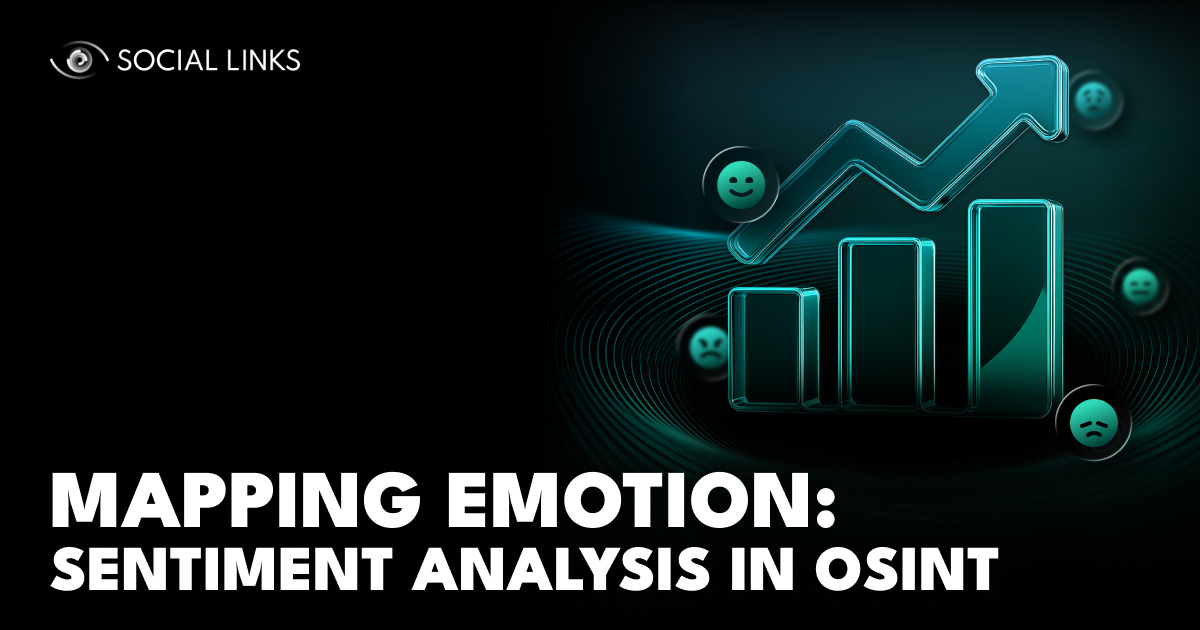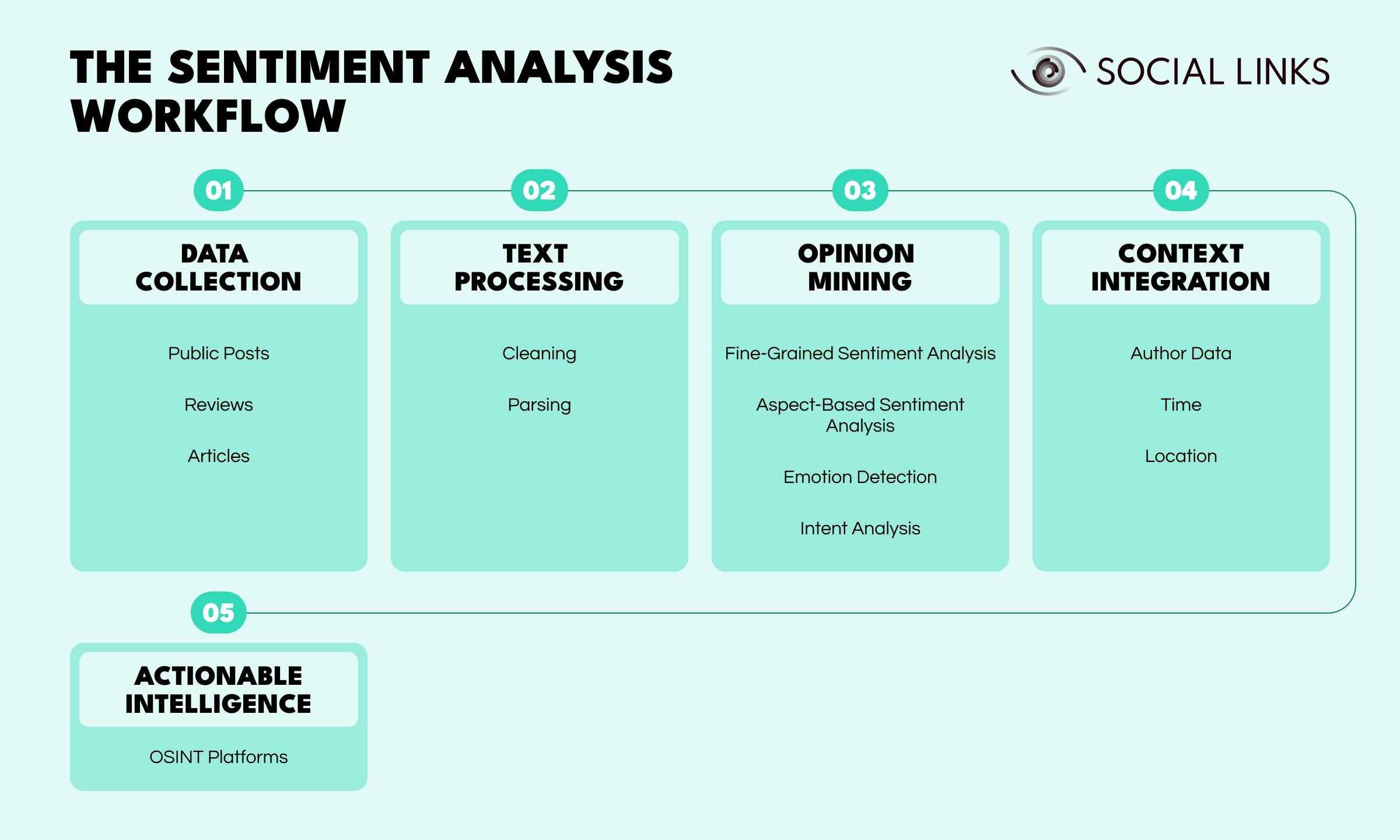Mapping Emotion: Sentiment Analysis in OSINT


In the endless stream of digital communication, every tweet, review, and comment contributes to a massive and chaotic archive of human emotion. Understanding what people think and how strongly they feel was once the domain of surveys and focus groups. Today, artificial intelligence can do it at scale and in real time.
This article explores how sentiment analysis, or opinion mining, turns raw text into structured insights. We’ll be looking at the discipline’s core methods, the ethical foundations of data collection, the tools powering modern analysis, and how advanced OSINT platforms integrate sentiment tracking into proactive intelligence workflows.

At its most basic, sentiment analysis classifies text as positive, negative, or neutral. But the real power of modern systems lies in how deeply they understand tone and context. While basic sentiment analysis is restricted to simple polarity, the modern approach of opinion mining can recognize categories of emotion, levels of intensity, and even communicative intent.
Advanced sentiment analysis is not a single method but a collection of approaches that—taken together—turn a simple sentiment score into a multidimensional profile of human expression. Key aspects of the discipline include:
Reaching beyond “good” or “bad”, this approach rates tone of expression on a spectrum (for example, very positive to very negative), helping zero in on just how strong a given emotion really is.
The process of categorization can deliver erroneous results if not sufficiently nuanced. A review like “The camera is great but the battery is awful” is in fact a dual insight, revealing praise for one feature and criticism for another. By breaking text into specific components, ABSA allows analysts to assess each part separately and get a truer picture of the content.
Opinions are not merely assertions—they carry bags of emotional content. The discerning analyst will therefore deploy emotion detection to identify this all-important driver, be it anger, or joy, or fear, etc. This is especially useful for risk and threat analysis, where tone can escalate quickly.
Communication is rarely without a purpose. This type of analysis goes a step beyond the recognition of semantic content to infer why it’s being deployed. It allows the analyst to infer what the author actually wants—whether they’re planning to buy, complain, or issue a warning.
Before any analysis begins, data must first be collected—and the way this is done matters just as much as what it reveals. In OSINT and investigative contexts, ethical data handling is non-negotiable.
Ethical intelligence relies on information intentionally shared in public spaces. No hacking, no guessing passwords, and no social engineering. If a user hasn’t made it public, it’s off-limits.
Each platform defines how its data can be used. Ethical tools use approved APIs or manual collection methods. Scraping or violating ToS can lead to bans or legal action, cutting off vital data sources.
This is about collecting only what’s necessary for a legitimate goal. Gathering irrelevant personal details increases privacy risks and weakens the defensibility of an investigation.
Violating these principles has real consequences. For law enforcement, improperly gathered data can be thrown out of court. For corporations, breaches of GDPR or privacy law can mean fines and reputational damage. Ethical OSINT isn’t just good practice—it’s risk management.
Once the ethics are in place, analysts can choose from a wide array of sentiment analysis tools, which vary depending on scale and use case. Common choices include:
The applications of sentiment analysis are equally wide-ranging, and deployed depending on the context and objective:
From Reactive Analysis to Proactive Monitoring
For investigators, a sentiment score alone is just a data point. Its real value emerges when it’s connected to context—who said it, where it came from, and what patterns it fits within. Integrated into a broader OSINT framework, sentiment analysis becomes more than observation; it becomes foresight.
In criminal or security contexts, early emotional escalation is often correlated with real-world operational planning. When sentiment signals are attributed to identities or mapped onto behavioral graphs, investigators can forecast escalation patterns with far greater confidence. To understand how attribution and investigative structure work in practice, see OSINT in Criminal Investigations: Methodologies and Best Practices.
This is where a platform like Crimewall stands out. Instead of offering sentiment tracking as a separate feature, it weaves it directly into the investigative workflow, turning raw emotional data into actionable intelligence.
Example: Imagine a public safety team monitoring digital chatter ahead of a major political rally. Rather than waiting for incidents to occur, analysts can configure dynamic alerts that identify potential threats as they form. A simple rule might look like this:
Mark any public post originating within five miles of the rally site that includes keywords such as “protest,” “riot,” or “attack” and registers a sentiment score below -0.7, signaling high negative emotion or anger.
When a match appears, Crimewall immediately flags the post for review. Within the same interface, the analyst can then:
This integrated approach transforms sentiment analysis from a passive measurement tool into a predictive capability. By filtering out noise and surfacing only high-risk signals, investigators can act faster, prioritize more effectively, and prevent escalation before it happens.
The predictive power becomes significantly stronger when emotional indicators are layered onto social graph structure. Network analysis reveals how sentiment flows through clusters, who amplifies hostility, and which bridge accounts act as accelerators. For a deeper breakdown of how social graph structure works in OSINT, see Relation and Structure: A Guide to Social Network Analysis.
Sentiment analysis has evolved from a simple binary meter into a nuanced instrument capable of reading emotion and intent. But its power must be harnessed conscientiously. Ethical data collection and contextual interpretation are inseparable from effective analysis.
The future of opinion mining lies in synthesis—data that’s ethically sourced, contextually understood, and seamlessly integrated into the larger intelligence picture. When combined, these principles turn a torrent of online chatter into structured, actionable insight, enabling organizations to act not just fast, but responsibly.
Keyword monitoring captures mentions, but sentiment analysis interprets meaning and emotion—it tells you not just what people are talking about, but how they feel about it.
Yes. When combined with contextual data like location or network links, negative sentiment can help flag early signs of coordinated campaigns or emerging risks.
As long as the data comes from genuinely public sources and respects platform Terms of Service, it’s legally and ethically acceptable. Private or restricted data must never be accessed.
Accuracy depends on the model and training data. General-purpose models perform well on large datasets, but specialized or multilingual contexts often require custom tuning for reliable results.
Want to see how integrated OSINT tools can transform the way you collect and analyze online sentiment? Book a personalized demo with one of our specialists and explore how Crimewall unifies sentiment analysis, data correlation, and visualization—all within a single investigative platform.